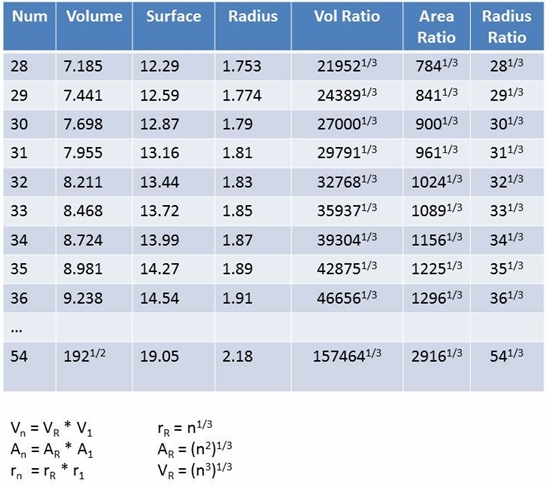The 3D model of the S|T unit is a composite of two 3D oscillations, the space oscillation, the SUDR, and the time oscillation, the TUDR. Since they are the inverse of each other, the SUDR is 27 times smaller than the TUDR. We can therefore use the SUDR volume, surface or radius to express the relationship numerically. For example, let’s use the volume:
54(1/27)/(27), (27(1/27)/(27), (27(1/27)/2(27), or(54/27)/27, 27/27, 27/54
As explained in the previous entry, only the unit measure of 3 volumes out of the lower 27, actually cube to an integer. 9, 18 and 27, which enables us to use them as 1/3, 2/3 and 3/3 of the whole, in 3D terms. Interestingly enough, however, in 1D terms, the numbers are different. Only three SUDR radii fit in a TUDR radius (i.e. 3 * (1/31/2) = 31/2), so the volume sum in which the SUDR radius is 1/3, 2/3 and 3/3 of the TUDR radius is 1, 8 and 27, respectively. I will defer the discussion of the ramifications of this fact until later. Right now I want to complete the other half of the numeric system, where the SUDR is larger than the TUDR, what we can refer to as the upper half of the number system, which terminates at 54/27.
Figure 1 below shows the chart of the upper half that corresponds to the chart of the lower half provided in the previous entry.

Figure 1. Chart of 27 SUDR Volumes Summing to Two TUDR Volumes
The concepts being introduced here are somewhat subtle. First, we assume that our universe is nothing but motion, with two reciprocal aspects, space and time, existing in discrete units. Since nothing is perfect, we must introduce a deviation into the perfect, one for one, expansion of space and time. The only deviation possible is a “direction” reversal in one of the two aspects, which produces a unit displacement in the otherwise perfect expansion.
We label the unit space displacement, SUDR, for space unit displacement ratio, and the unit time displacement, TUDR, for time unit displacement ratio. In simple terms the SUDR is a 3D space oscillation, while the TUDR is the inverse of this, a 3D time oscillation.
These two fundamental units progress, or increase, in their respective non-oscillating aspects. For the SUDR, this means that for each half of its oscillation, time continues to expand, and for the TUDR, space continues to expand, during each half of its oscillation. If we chart these motions we see that they are perpendicularly oriented, because they are reciprocals. Hence, it is possible that the time expansion of a space oscillation (SUDR) could bring it into contact with the space expansion of a time oscillation (TUDR).
A combination of these two fundamental entities constitutes a new ratio of space and time, a SUDR|TUDR (S|T) unit. A little consideration will show that an S|T unit is an oscillating combination that propagates in both space and time, and therefore can come into contact with other instances of S|T units, forming compound units. Consequently, we need to calculate the properties of this fundamental scalar motion combo in order to explore the possible combinations that might occur and then compare them to observations.
From simple geometric and mathematical properties, we deduce that the radius of the smallest TUDR is the square root of 3, and that the radius of the largest SUDR is the inverse of this, which means that, while it is three times smaller than the radius of the TUDR, its volume is exactly 27 times smaller than the volume of the TUDR.
Of course, these sizes are all relative until we choose a unit for the scale, which undoubtedly must be based on the speed of light.